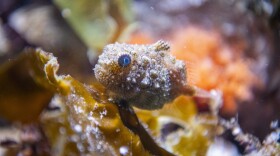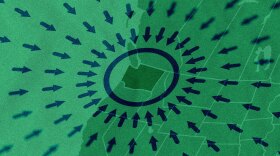Scientists have deciphered some of the secrets of one of Puget Sound’s natural recyclers. It’s a microbe – which likes to eat sulfur and nitrogen – and might be found near any of our beaches.
The technique they devised could open the door to a better understanding of microbial life that abounds everywhere – in the oceans, in soils, and in the human body.
The work comes from the University of Washington oceanography lab of Ginger Armbrust, with the lead role by PhD candidate Vaughn Iverson, who used computer skills from his previous life working for Intel and applied them to biology.
They started this particular project at the beach at Golden Gardens Park in Seattle.
"It was a May morning, we were here about 9 o'clock in the morning, and it was a beautiful spring day," recalls Iverson, standing on the wide sandy beach. Several members of their oceanography lab put on hip-waders and dragged a container the size of a big barrel into the water.
"We took the lids off and filled them with water from the surface, and then we lugged dragged them back on the beach," says Iverson. "We didn't know what we were going to find – we just wanted to find out what was there."
They were not surprised that their very ordinary barrel of water was teeming with organisms that are too small to see – "about 5 million cells in a teaspoon of water," he says.
"Microbes are critical important, they are the big recyclers. But we don’t really know in great detail what they are doing," says Armbrust.
Most micro-organisms are studied by creating a "culture" of them, grown in the lab, which allows scientists to perform tests and experiments on them. However, that has severely limited what's been studied.
"About 99 percent of the microbes that live out there, we can't grow them in the lab," she says.
It’s like picking a delicate flower – they die quickly if you isolate them from the rest of their habitat. Many microbes depend on other life-forms for essential nutrients.
DNA gathering
Armbrust and Iverson developed a new approach, building on a type of biology called metagenomics. They put those millions of organisms together into a machine that analyzes all the DNA you could find there. That left them with as much code as a library filled with 15,000 copies of War and Peace.
Their innovation was finding a way to piece together the genetic code of a single organism out of all of that data. It's like putting together a jigsaw puzzle with a million pieces – if all those pieces were shaken up together with a few hundred completely different puzzles. Their results, and how they took advantage of huge progress in computing power, are explained in the journal Science.
They're able to deduce a few things about their target microbe, the poetically named, “marine group II euryarchaeota.” Its genes reveal that it has a little tail, a flagellum, that allows it to move, and now they know that it prefers the community of phytoplankton.
Armbrust says scientists can apply this new technique more widely:
"There are going to be a lot of microbes that are beneficial but we just don’t know exactly what they do, because we haven't been able to culture them. This approach will allow us to get a handle on those organisms."
For example, "50 percent of all the biomass in the oceans are organisms that are too small to see," she says. She's focusing now on decoding the secrets of plankton – which provide half the world’s oxygen.







